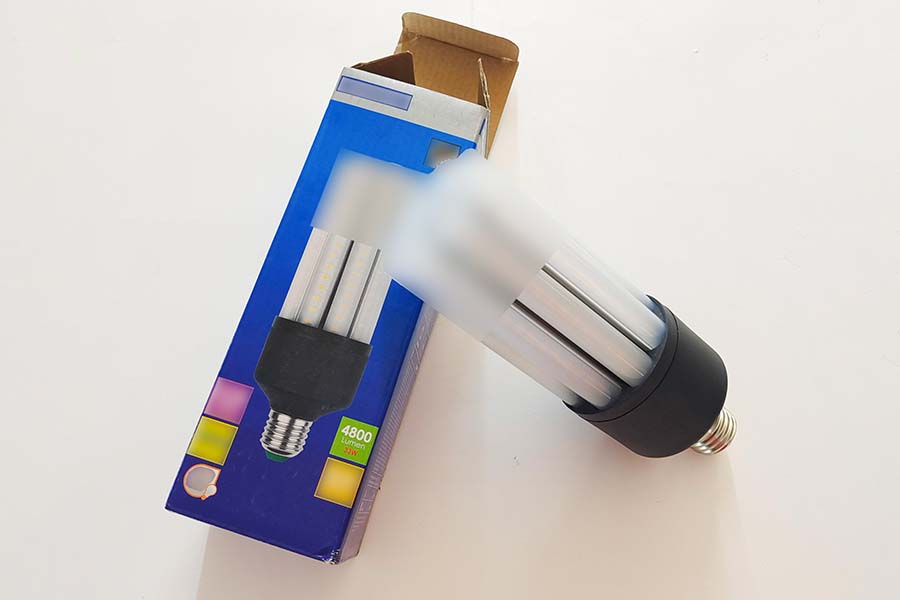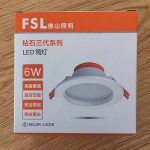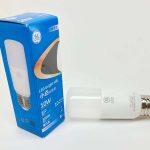Explain how to obtain better LED light quality with a real example
The quality of LED corn light bulbs is a combination of multiple parameters.
And those parameters are not easy to identify without instruments, skills, and experience.
The top leading brands usually place a significant emphasis on the quality of their lights.
They have a quality management team of their professionals.
But still work with third-party quality inspection companies for even better quality assurance.
Meanwhile, some other companies place an important emphasis on marketing strategies.
For example, package designs, graphics designs, online promotion, etc.
Whichever approach the brands take, the fundamental functions and parameters remain unchanged.
But did you know which brands offer better quality?
It’s not a mission impossible.
You need to understand the essential things for the quality of LED lights.
Recently, we got an LED corn light bulb from a brand, which claims they originated in Germany.
It gives us a remarkable impression of their quality.
So, we decide to get a sample to verify.
It’s a great light regarding the overall materials and performance.
But we see something, if improved, then this light will be perfect.
We’ll explain what we’ve seen one by one.
Below is some basic information about this sample.
Specifications:
- 33W, 2,800K, 4,800lm, 220-240V
1. First Thing to Consider Before You Buy
An LED corn light is an assembly of LEDs on a metal structure.
The yellow LEDs assembled on the fixture look like corn.
LED corn light bulbs provide a high output of light using LEDs, which will need a lot of LEDs.
- This type of lights is commonly used in the lighting industry.
- They have high light output and low energy usage.
- It is a combination of both the lighting quality and money saved in your home or business.
The sales package of the sample indicates that it has a wattage of 33W.
And it has a Lumen value of 4,800.
Both numbers look good based on the rule of thumb.
Usually, LED corn light bulbs are used as light sources.
Therefore, it’d be good to pick the ones that are bright.
It is worth considering for its rated wattage and lumens.
2. First Impression on Overall Design
You can feel the weight if you take it by hand.
Not something that is made of plastic and doesn’t seem to be heavy.
Guess this is because it has a structure made of aluminum, rather than plastics.
- Aluminum is an ideal material for efficient heat dissipation.
- Heat dissipation is a critical factor that determines the life spans of LEDs.
Good heat dissipation is unquestionably helpful for a longer life span of LED lights.
We can say this light bulb has a solid foundation for a long life span, thanks to its heat sink.
Meanwhile, an LED corn light bulb usually has multiple rows of LEDs.
Cooling may not be sufficient if only depends on the material itself.
Therefore, adding a cooling fan is another important heat dissipation solution.
- This sample has a cooling fan fastened with screws on the top.
- This usually raises heat dissipation to another level.
It’s a common practice to install LED corn lights inside a shade or something.
The air is not flowing inside without an additional cooling mechanism.
This is a common cause for some LED lights to fail within a sealed working environment.
The LED corn light bulb has both an aluminum structure and a cooling fan.
It is not trying to save on material costs.
So, we can say it has a foundation for good quality.
A good product will need an optimum amount of materials.
This is undeniable.
We’ve told you about our first impression on this LED corn light bulb.
After the first impression, we are going to talk about 2 sides of this sample.
- The quality of its electronic hardware
- The quality of the light it produces
We use professional instruments to test this sample.
BackMorning does such tests using the same instruments for some other household names.
And we will explain each term in detail.
3. Voltage Range
Voltage is an essential parameter for almost all electronic products.
As for LED lights, make sure they work properly within a voltage range.
Avoid those which won’t work if the input voltage changes a little bit.
Not sure whether you don’t know it.
A power grid doesn’t provide electricity always at a fixed value.
Actually, it supplies electricity within a voltage range.
220-240V is a common voltage range.
It’s important to make sure the light will work normally within its rated voltage range.
That means the LED light won’t flick when the input voltage rises or drops within its rated range.
This is the bottom line for the quality of LED lights.
As for the corn light bulb, it doesn’t flick within its applicable voltage 220-240V.
4. Spectrum Test
Next, we will tell you the quality of its light with numbers one by one.
Below is the data that we’ve got after testing it with an integrating sphere.
You will need an integrating sphere and put the light inside to obtain those numbers.
Meanwhile, you will also need the knowledge, skills and experience to properly set up the test.
If you don’t have a professional, you can consider working with a third-party quality inspection company like BackMorning.
The performance of electronic products may go down to a certain extent as time goes by.
Therefore, we collect the data 2 times respectively.
- One is when the light goes on for 1 minute.
- The other is after 30 minutes.
In this case, the data will be more reliable.
1). Total Lumen
The term Lumen is one of the critical parameters for measuring the brightness of a light bulb.
The higher the number of Lumens, the brighter the light bulb.
If you want a brighter light bulb, pick the one with a bigger Lumen value.
Here we can see that the sample produces:
- 4,515.3 Lumens at 1 minute, which is about 5.9% less than its rated value 4,800 Lumens.
- 4,286.7 Lumens at 1 minute, which is about 10.7% less than its rated value 4,800 Lumens.
As a common practice, it can be acceptable to have a tolerance -/+10%.
This is a common standard among the top lighting brands.
But not mandatory for all the LED lighting manufacturers and sellers.
- The rated Lumen value 4,800 is not a small number.
- The tested value of this sample drops by 10.7% at 30 minutes.
- That’s beyond the bottom line of tolerance.
2). LM/W
Another important factor when choosing an LED bulb is energy efficiency.
That is how much light a bulb produces, measured in Lumen/Wattage.
The higher the number is, the brighter it will be.
A bigger number of LM/W is more favorable than a smaller number.
You want to choose a more energy-efficient light bulb after all.
The package doesn’t indicate a rated value for its LM/W.
But we can calculate it by a formula:
- Rated Lumen / Rate Wattage (4,800 Lumens / 33 W) = 145.45.
- The tested value that we got is 131.76 LM/W at 1 minute (9.4% less than the rated value).
- And the 2nd value is 129.3 at 30 minutes (11.1% less than the rated value).
Again, the acceptable tolerance is -/+10%.
This is a common standard among the top lighting brands.
But not mandatory for all the LED lighting manufacturers and sellers.
This light has a tested LM/W value about 130.
It’s lower than its theoretical bottom line, but not a bad number.
Many nonbrand LED lights don’t even have such a value at all.
3). RA
The value Ra is about how colors look under a light source, compared with sunlight.
- The parameter is measured from 0-100.
- A perfect 100 indicates that colors under the light source appear the same as they would under natural sunlight.
This light doesn’t indicate a rated value for its Ra on its sales package.
- The tested value is 81.4, measured at 1 minute
- And the value is also 81.4, measured at 30 minutes
Usually, LED corn light bulbs are used installed where the space is comparatively larger.
- The major purpose is to illuminate the environment so you can see things.
- Typical examples can be the basement, the garage, etc.
- But not to let you identify the colors of objects very clearly.
For this reason, we can say the tested value of 81.4 is great.
4). SDCM
SDCM is a measure of how far the color of light emitted by a LED light bulb deviates from the target color.
Therefore, the lower the number of SDCM, the better for the LED light bulbs.
It’d be better to choose LED light bulbs consistent in their color and brightness.
So, when you install multiple of them in a row, one light won’t look obviously different from another.
- The light bulb sample has an SDCM value 2.2, measured at 1 minute.
- And another value 2.8, measured at 30 minutes.
This is a great result.
Worth considering if you need to install multiple of them together.
5). CCT
CCT stands for Correlated Color Temperature.
It is a way of measuring the color of a light source.
The higher the number, the cooler (bluer) the light looks.
A CCT of 2,700K is more yellowish than 5,000K which is more white.
- The rated CCT value of this LED light bulb is 2,800K
- While the tested CCT value is 2,709 K, measured at 1 minute
- And 2,724 K, measured at 30 minutes
This value is within its acceptable tolerance.
6). Wattage
Wattage indicates how much electricity that a light bulb uses.
Good to have a high value for Lumen while a low number for wattage.
- The rated value for this corn light bulb is 33W
- The tested value is 34.2W, measured at 1 minute
- While the tested value is 33.1W, measured at 30 minutes
This light is telling this number quite accurately.
5. Conclusion
1). Pro:
This LED corn light bulb has great performance regarding the quality of light – Color rendering, uniformity, and color temperatures.
It has indicated its wattage quite accurately on its sales package.
2). Con:
The energy efficiency is below the bottom line of the commonly acceptable tolerance -/+10%.
Therefore, it’s incomparable to those global top-selling brands.
But still better than many other nonbrands in the market.
It’ll be a perfect light if they can improve its energy efficiency.
Last but not least, LED lights are sophisticated products.
It is not as easy as it appears to determine their quality properly.
We’ve explained to you how to make LED lights better with a real example.
There is still more than that we can do to help you with LED light manufacturers.
Feel free to contact us.
We can help you with buying good LED lights.
Thanks for reading!













